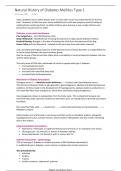Class notes
Natural history of type 1 diabetes mellitus
- Course
- Institution
Delve into the etiology and pathogenesis of Type 1 Diabetes Mellitus, including the autoimmune processes that lead to beta-cell destruction and insulin deficiency. Understand the hallmark symptoms, diagnostic criteria, and the stages of T1DM, providing a clear picture of the disease progression ...
[Show more]



